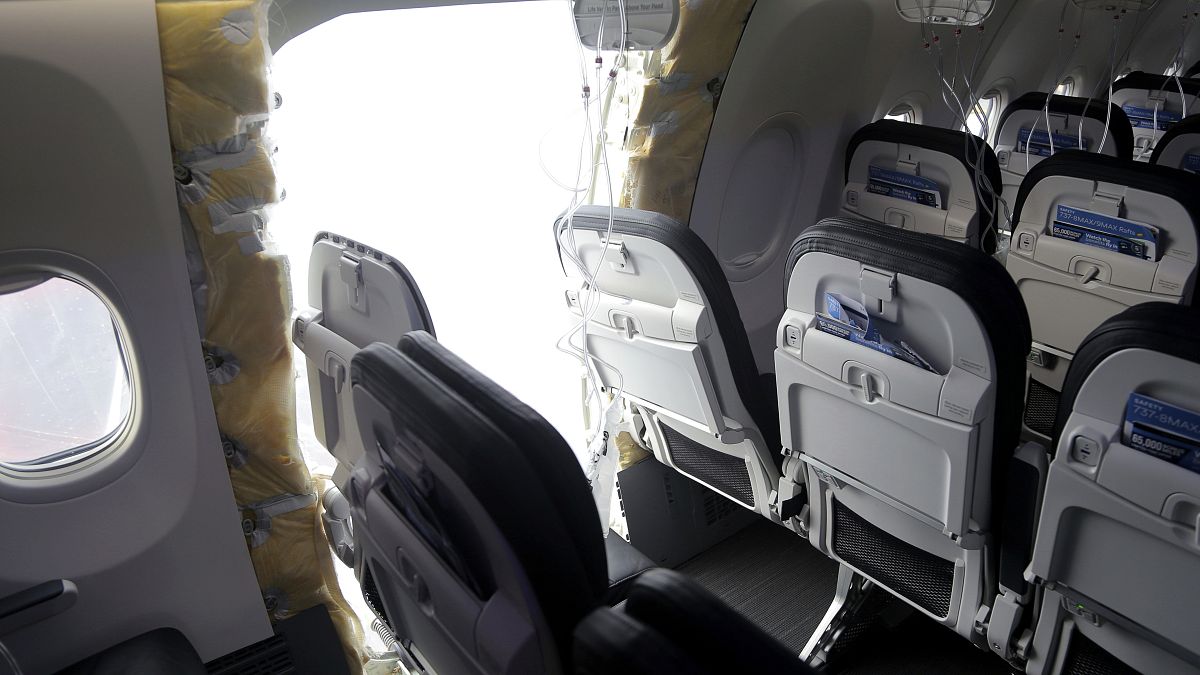On Friday, a fuselage panel blew out on an Alaska Airlines Boeing 737 Max 9 plane seven minutes after takeoff from Portland, Oregon.
The rapid loss of cabin pressure pulled the clothes off a child and caused oxygen masks to drop from the ceiling, but miraculously none of the 171 passengers and six crew members were injured.
Hours after the terrifying incident, Alaska Airlines announced that it would ground its entire fleet of 65 Max 9s for inspections and maintenance.
But how did this malfunction occur and how likely is it to happen again?
Why did a panel blow out on a Boeing aeroplane?
On Sunday, investigators said they had found the piece of fuselage that blew off the Boeing airliner and hoped it would provide physical evidence of what went wrong.
The gaping hole in the side of the Alaska Airlines jet opened up where aircraft maker Boeing fits a ‘plug’ to cover an emergency exit that the airline does not use. The plugs are on most Boeing 737 Max 9 jets.
The Federal Aviation Administration has temporarily grounded those planes until they undergo inspections of the area around the door plug.
The National Transportation Safety Board (NTSB) has begun an investigation that is likely to last months and focus on the panelled-over exit door that blew off.
A federal official also said that the Alaska Airlines Max 9 was not being used for flights to Hawaii after a warning light that could have indicated a pressurisation problem lit up on three different flights.
Alaska Airlines decided to restrict the aircraft from long flights over water so the plane “could return very quickly to an airport” if the warning light reappeared, said Jennifer Homendy, chair of the NTSB.
Homendy cautioned, however, that the pressurisation light might be unrelated to Friday’s incident.
Airlines ground Boeing 737 jets for safety inspections
Alaska Airlines has grounded its entire fleet of 65 Max 9s for inspections and maintenance.
The company said it had cancelled 170 flights on Sunday, affecting 25,000 passengers, and expects cancellations to continue through the first half of the week.
Early on Monday, 20 per cent of the carrier's flights were cancelled - 139 in all - according to the flight tracking site FlightAware.
United Airlines, the world’s biggest operator of Max 9s, grounded its entire fleet of 79 Max 9s and is seeking to “clarify the inspection process and requirements for returning” them to service.
Six other airlines use the Max 9: Panama's Copa Airlines, Aeromexico, Turkish airlines, Icelandair, flydubai and SCAT Airlines in Kazakhstan, according to aviation data services Cirium.
While the European Union Aviation Safety Agency (EASA) has similarly taken the decision to ground these aircraft, it says no EU airlines currently use them in the same configuration as the affected Alaska Airlines flight and therefore none have been grounded.
How safe are Boeing 737 planes?
Federal officials and airline executives regularly tout the safety of air travel.
There has not been a fatal crash of a US airliner since 2009 when a Colgan Air plane operated for Continental crashed near Buffalo, New York, killing all 49 people on board and one on the ground.
However, a surge in close calls between planes at US airports in the past year prompted the Federal Aviation Administration (FAA) to convene a ‘safety summit’ last year, in which officials encouraged airlines and pilots to redouble their attention to careful flying.
The incident has also renewed questions about the safety of Boeing's Max aircraft, which is the newest version of the company's storied 737.
There are two versions of the aircraft in service: the Max 8 and the Max 9, which is the larger of the two.
Regulators around the world grounded Max 8 planes for nearly two years after a Lion Air flight crashed in Indonesia in 2018, and an Ethiopian Airlines Max 8 crashed in 2019.
Boeing changed an automated flight control system implicated in the crashes.
Last year, the FAA told pilots to limit the use of an anti-ice system on the Max in dry conditions because of concern that inlets around the engines could overheat and break away, possibly striking the plane.
And in December, Boeing told airlines to inspect the planes for a possible loose bolt in the rudder-control system.
However, those past issues are unrelated to Friday's blowout, which is an exceedingly rare event in air travel.
Anthony Brickhouse, a professor of aerospace safety at Embry-Riddle Aeronautical University, said it's too soon to say whether the blowout involved an issue with Max 9s or that specific flight.
Brickhouse said passengers should feel confident that regulators and airlines will make sure the grounded Max 9s are safe before returning them to service.
He added that it was lucky the emergency occurred shortly after takeoff when passengers were all seated with their seatbelts on.
But he said that doesn't mean passengers should feel scared to leave their seats once the pilot turns off the ‘fasten seatbelt’ sign because it's very unlikely for holes to open in the fuselages of airliners.
The Boeing company issued a brief statement saying “we deeply regret the impact this event has had on our customers and their passengers.”
Boeing said it supported the FAA’s decision to require immediate inspections and said it was providing technical help to the investigators. The company has declined to make an executive available for interviews.


